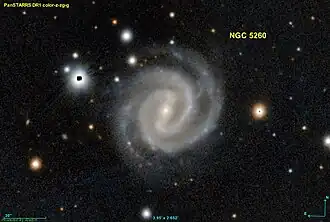NGC 5260
| NGC 5260 | |
|---|---|
 NGC 5260 imaged by Pan-STARRS | |
| Observation data (J2000 epoch) | |
| Constellation | Hydra |
| Right ascension | 13h 40m 19.8871s[1] |
| Declination | −23° 51′ 28.813″[1] |
| Redshift | 0.021688[1] |
| Heliocentric radial velocity | 6502 ± 7 km/s[1] |
| Distance | 326.6 ± 22.9 Mly (100.13 ± 7.02 Mpc)[1] |
| Group or cluster | RR 254 |
| Apparent magnitude (V) | 12.8[1] |
| Characteristics | |
| Type | SB(s)c[1] |
| Size | ~248,900 ly (76.32 kpc) (estimated)[1] |
| Apparent size (V) | 1.6′ × 1.4′[1] |
| Other designations | |
| IRAS 13375-2336, 2MASX J13401990-2351291, MCG -04-32-050, PGC 48371, ESO 509- G 092, RR 254a[1] | |
NGC 5260 is a barred spiral galaxy in the constellation of Hydra. Its velocity with respect to the cosmic microwave background is 6789 ± 21 km/s, which corresponds to a Hubble distance of 100.13 ± 7.02 Mpc (~327 million light-years).[1] It was discovered by American astronomer Lewis Swift on 6 April 1885.[2]
According to the SIMBAD database, NGC 5260 is a Seyfert II galaxy, i.e. it has a quasar-like nuclei with very high surface brightnesses whose spectra reveal strong, high-ionisation emission lines, but unlike quasars, the host galaxy is clearly detectable.[3]
NGC 5260 forms a physical pair with galaxy ESO 509- G 093, collectively named RR 254, with an optical separation of 241″ between them.[4]
Supernovae
Two supernovae have been observed in NGC 5260:
- SN 2022jkx (Type Ib, mag. 18.819) was discovered by ATLAS on 3 May 2022.[5]
- SN 2023dtd (Type II, mag. 18.516) was discovered by ATLAS on 20 March 2023.[6]
See also
References
- ^ a b c d e f g h i j k "Results for object NGC 5260". NASA/IPAC Extragalactic Database. NASA and Caltech. Retrieved 9 August 2024.
- ^ Seligman, Courtney. "Celestial Atlas Entry for NGC 5260". cseligman.com. Retrieved 9 August 2024.
- ^ "NGC 5260". SIMBAD. Centre de données astronomiques de Strasbourg. Retrieved 16 December 2024.
- ^ Reduzzi, L; Rampazzo, R. (1995). "Candidates for a southern extension of the Karachentsev catalogue of isolated pairs of galaxies". Astrophysical Letters and Communications. 30: 1–229. Bibcode:1995ApL&C..30....1R.
- ^ "SN 2022jkx". Transient Name Server. IAU. Retrieved 16 December 2024.
- ^ "SN 2023dtd". Transient Name Server. IAU. Retrieved 16 December 2024.
External links
 Media related to NGC 5260 at Wikimedia Commons
Media related to NGC 5260 at Wikimedia Commons- NGC 5260 on WikiSky: DSS2, SDSS, GALEX, IRAS, Hydrogen α, X-Ray, Astrophoto, Sky Map, Articles and images